Related Research Articles

The Kordofanian languages are a geographic grouping of five language groups spoken in the Nuba Mountains of the South Kordofan region of Sudan: Talodi–Heiban languages, Lafofa languages, Rashad languages, Katla languages and Kadu languages. The first four groups are sometimes regarded as branches of the hypothetical Niger–Congo family, whereas Kadu is now widely seen as a branch of the proposed Nilo-Saharan family.

Niger–Congo is a hypothetical language family spoken over the majority of sub-Saharan Africa. It unites the Mande languages, the Atlantic–Congo languages, and possibly several smaller groups of languages that are difficult to classify. If valid, Niger–Congo would be the world's largest in terms of member languages, the third-largest in terms of speakers, and Africa's largest in terms of geographical area. It is generally considered to be the world's largest language family in terms of the number of distinct languages, just ahead of Austronesian, although this is complicated by the ambiguity about what constitutes a distinct language; the number of named Niger–Congo languages listed by Ethnologue is 1,540.
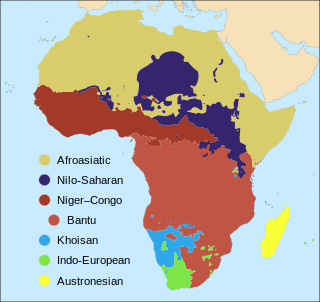
The number of languages natively spoken in Africa is variously estimated at between 1,250 and 2,100, and by some counts at over 3,000. Nigeria alone has over 500 languages, one of the greatest concentrations of linguistic diversity in the world. The languages of Africa belong to many distinct language families, among which the largest are:

Benue–Congo is a major branch of the Volta-Congo languages which covers most of Sub-Saharan Africa.
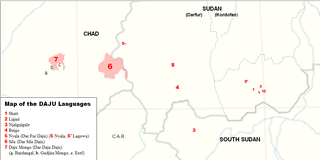
The Daju languages are spoken in isolated pockets by the Daju people across a wide area of Sudan and Chad. In Sudan, they are spoken in parts of the regions of Kordofan and Darfur, in Chad they are spoken in Wadai. The Daju languages belong to the Eastern Sudanic subfamily of Nilo-Saharan.

In most classifications, the Eastern Sudanic languages are a group of nine families of languages that may constitute a branch of the Nilo-Saharan language family. Eastern Sudanic languages are spoken from southern Egypt to northern Tanzania.

The Atlantic–Congo languages are the largest demonstrated family of languages in Africa. They have characteristic noun class systems and form the core of the Niger–Congo family hypothesis. They comprise all of Niger–Congo apart from Mande, Dogon, Ijoid, Siamou, Kru, the Katla and Rashad languages, and perhaps some or all of the Ubangian languages. Hans Günther Mukarovsky's "Western Nigritic" corresponded roughly to modern Atlantic–Congo.
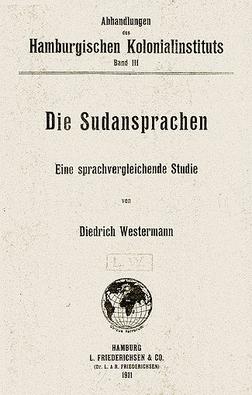
In early 20th century classification of African languages, Sudanic was a generic term for languages spoken in the Sahel belt, from Ethiopia in the east to Senegal in the west.
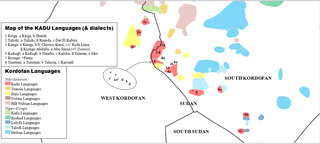
The Kadu languages, also known as Kadugli–Krongo or Tumtum, are a small language family of the Kordofanian geographic grouping, once included in Niger–Congo. However, since Thilo Schadeberg (1981), Kadu is widely seen as Nilo-Saharan. Evidence for a Niger-Congo affiliation is rejected, and a Nilo-Saharan relationship is controversial. A conservative classification would treat the Kadu languages as an independent family.
Umbundu, or South Mbundu, one of many Bantu languages, is the most widely-spoken autochthonous language of Angola. Its speakers are known as Ovimbundu and are an ethnic group constituting a third of Angola's population. Their homeland is the Central Highlands of Angola and the coastal region west of these highlands, including the cities of Benguela and Lobito. Because of recent internal migration, there are now also large communities in the capital Luanda and its surrounding province, as well as in Lubango.
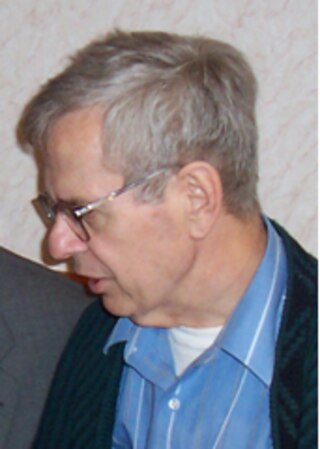
Marvin Lionel Bender was an American linguist.

The Rashad languages form a small language family in the Nuba Hills of Sudan. They are named after Rashad District of South Kordofan.

The Talodi–Heiban languages are a proposed branch of the hypothetical Niger–Congo family, spoken in the Nuba Mountains of Sudan. The Talodi and Heiban languages are thought to be distantly related by Dimmendaal, though Glottolog 4.4 does not accept the unity of Talodi–Heiban pending further evidence.

Ellen Contini-Morava is an anthropological linguist, interested in the meanings of linguistic forms, discourse analysis, functional linguistics and (noun) classification; in particular, in the relationship between lexicon and grammar. She specializes in Bantu languages in general, and Swahili in particular.
Chama cha Kiswahili cha Taifa is a Kenyan institution founded in 1998 responsible for the promotion of the Swahili language in Kenya. The Founding Chair is Prof. Kimani Njogu, a graduate of Yale University's department of Linguistics.
Lumun (Lomon), also Kuku-Lumun, is a Niger–Congo language in the Talodi family spoken in the Nuba Mountains, Sudan.

Tegali is a Kordofanian language in the Rashad family, which is thought by some to belong to the hypothetical Niger–Congo phylum. It is spoken in South Kordofan state, Sudan.
Acheron (Asheron) is a Niger–Congo language in the Talodi family spoken in South Kordofan, Sudan.
Archibald Norman Tucker was a Cape Colony-born linguist specializing in Bantu languages. He earned his MA degree at the University of Cape Town. He did some study of Bantu languages in southern Africa and also made a trip to Sudan to study languages there. He worked as Linguistic Expert of non-Arabic languages for the Sudan Government from 1929 to 1931. He later moved to England in 1931. In London, Tucker studied under Alice Werner and Daniel Jones, earning his Ph.D. at University College London. Later he studied for a short time under Carl Meinhof in Hamburg.
Proto-Niger–Congo is the hypothetical reconstructed proto-language of the proposed Niger–Congo language family.
References
- ↑ "Thilo Christian Schadeberg". hoogleraren.universiteitleiden.nl (in Dutch). Leiden University. 2022. Retrieved 24 November 2022.
- ↑ "Journal of African Languages and Linguistics. Edited by: Felix K. Ameka, Azeb Amha". degruyter.com. Walter De Gruyter GmbH. 2022. Retrieved 8 December 2022.
- ↑ "Titelei Volume 5, Number 2, October 1983". degruyter.com. Walter De Gruyter GmbH. October 13, 2009. Retrieved 8 December 2022.
- ↑ "Titelei Volume 11, Number l, April 1989". degruyter.com. Walter De Gruyter GmbH. October 13, 2009. Retrieved 8 December 2022.
- ↑ Newman, Paul (2010). "The making of JALL: Its beginnings and intellectual foundations". scholarworks.iu.edu. Indiana University. Original article: Journal of African Languages and Linguistics 31(1): 3-11. Retrieved 8 December 2022.
The Journal of African Languages and Linguistics (JALL) was founded in 1979 at the University of Leiden, with Paul Newman as Editor and Thilo Schadeberg as Associate Editor.
- ↑ "Prof. dr. Thilo Schadeberg. Geesteswetenschappen. Taal- en letterkunde overige taalgroepen". knaw.nl (in Dutch). KNAW, Royal Netherlands Academy of Arts and Sciences. Retrieved 24 November 2022.
- ↑ Akinwumi, Olutosin (2004). "Team. Thilo C. Schadeberg". afrikanistik.uni-bayreuth.de. Retrieved 24 November 2022.
- ↑ "Articles". scholar.google.com. Google. 2022. Retrieved 24 November 2022. Search for Thilo Schadeberg.
- ↑ Schadeberg, Thilo C. (1981). "Kordofanian". scholarlypublications.universiteitleiden.nl. Leiden University. Retrieved 24 November 2022.
- ↑ Schadeberg, Thilo C. (1982). "Nasalization in Umbundu". scholarlypublications.universiteitleiden.nl. Leiden University. Retrieved 24 November 2022.
- ↑ Schadeberg, Thilo C. (1982). "Les suffixes verbaux séparatifs en bantou". scholarlypublications.universiteitleiden.nl. Leiden University. Retrieved 24 November 2022.
- ↑ Schadeberg, Thilo C. (1986). "Tone cases in Umbundu". scholarlypublications.universiteitleiden.nl. Leiden University. Retrieved 24 November 2022.
- ↑ Schadeberg, Thilo C. (1989). "Kordofanian". scholarlypublications.universiteitleiden.nl. Leiden University. Retrieved 24 November 2022.
- ↑ Schadeberg, Thilo C.; Samson, Ridder (1994). "Kiinimacho cha mahali: Kiambishi tamati cha mahali-ni". scholarlypublications.universiteitleiden.nl. Leiden University. Retrieved 24 November 2022.
- ↑ Schadeberg, Thilo C. (1994). "John Benjamins e-Platform". jbe-platform.com. John Benjamins. Retrieved 24 November 2022.
Many Bantu languages have the balanced seven-vowel system i I ε a ɔ υ u. It is the system that one would, on internal evidence, reconstruct for proto-Bantu. Many other Bantu languages have a reduced five-vowel system i εaɔυu.
- ↑ Schadeberg, Thilo C. (1995). "Object diagnostics in Bantu". scholarlypublications.universiteitleiden.nl. Leiden University. Retrieved 24 November 2022.
- ↑ Schadeberg, Thilo C. (2002). "Progress in Bantu lexical reconstruction". degruyter.com. De Gruyter. Retrieved 24 November 2022.
- ↑ Schadeberg, Thilo C. (2003). "Chapter 5. Derivation, in Nurse, D. and Philippson, G., Eds., The Bantu Languages, Routledge Language Family Series". routledgehandbooks.com. Routledge, London. Retrieved 24 November 2022.